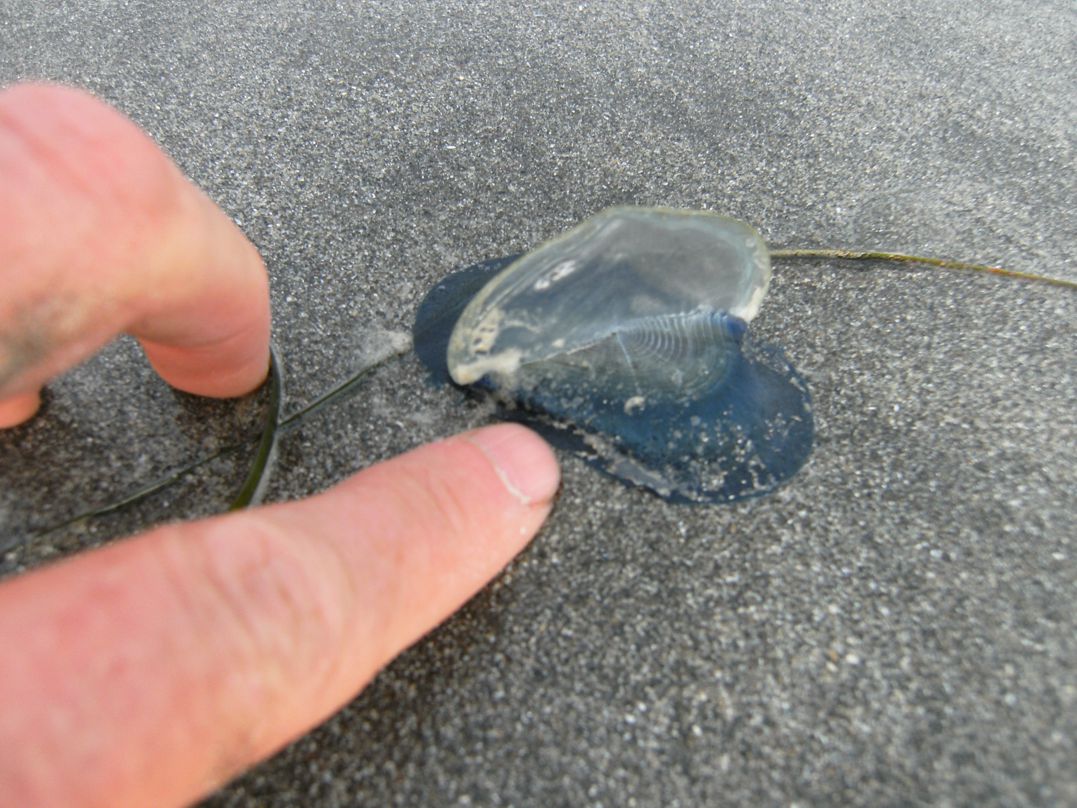Velella velella (Linnaeus, 1758)Common name(s) By-the-wind sailor |
|
| Synonyms: Velella lata | 
Top view of Velella velella. Note blue disk and clear, angled chitinous float. |
| Phylum Cnidaria
Class Hydrozoa Order Chondrophora (previously Siphonophora) Family Velellidae |
|
Underside of Velella velella, showing short tentacles. |
|
| Photos by: Dave Cowles at San Simeon, CA | |
How to Distinguish from Similar Species: There are no similar species. The attached colonial hydrozoan Tubularia has a similarly structured (though much smaller) polyp but would not be mistaken for this species. The 'bluebottle' found for example in Australia is a similar color of blue but has an inflated float like a Portuguese man-of-war.
Geographical Range: The species is pelagic and usually offshore (oceanic), though thousands may be blown ashore by strong onshore winds (especially during El Nino), mostly during late spring and early summer. It occurs worldwide in temperate and tropical seas.
Depth Range: Float on surface (pleuston).
Habitat: Worldwide in temperate and tropical seas. Oceanic
Biology/Natural History: This species is a puzzling one. It has long been regarded by many as a type of siphonophore; a pelagic colony of hydrozoan polyps similar to Physalia, the Portuguese man-of-war. Recent study suggests that, instead, it is a single very large hydrozoan polyp (Order Chondrophora), floating mouth downward and with a chitinous float and sail instead of a column. If so, it is an extremely large polyp for a hydrozoan. At any rate, the underside also includes many small polyps that bud off small medusae. The medusae (up to 1.5 mm tall) sink to as far as 2000 m depth and produce gametes. The developing embryos develop floats and rise back to the surface. This species is oceanic, being usually found far offshore. The angled sail makes it sail at 45 degrees from the prevailing wind. Some have a sail angled to the left, others to the right. Off California the right-angled form prevails, and these remain offshore in the prevailing northerly winds. Strong southerly or westerly winds, however, may bring huge aggregations ashore. Velella have symbiotic algae (zooxanthellae) in their tissues, and also feed on zooplankton. They are eaten by pelagic gastropods such as some nudibranchs and bubble-rafting snails. The pelagic gooseneck barnacle Lepas anatifera occasionally attaches to the dead chitinous floats. This species has many nematocysts and a few people have reported feeling a sting, but I have handled many and have never been stung even slightly. The species feeds on fish eggs and crustacean larvae.
Jones
et al. (2021), see also the Washington Sea Grant article,
report that Velella
velella experiences mass strandings all along the US
Pacific coast when winds switch to onshore in the spring, especially
after warm winters.
| Return to: | |||
| Main Page | Alphabetic Index | Systematic Index | Glossary |
References:
Dichotomous keys:Carlton, 2007
Kozloff, 1987, 1996
Smith and Carlton, 1975
General References:
Barnes,
1980
Brusca
and Brusca, 1990
Kozloff,
1993
Morris
et al., 1980
Washington
Sea Grant news article 2021
Scientific
Articles:
Francis, Lisbeth, 1985. Design of a small cantilevered sheet:
the sail of Velella
velella.
Pacific Science 39: 1 pp. 1-15
Francis, Lisbeth, 1991. Sailing downwind: Aerodynamic performance of the Velella sail. Journal of Experimental Biology 158: 117-132
Jones, Timothy, Jilia K. Parrish, and Hillary K. Burgess, 2021. Long-term patterns of mass stranding of the colonial cnidarian Velella vella: Influence of environmental forcing. Marine Ecology Progress Series 662 pp. 69-83. DOI: https://doi.org/10.3354/meps13644
General Notes and Observations: Locations, abundances, unusual behaviors, etc.:

In the summer of 2014 a huge number of by-the-wind sailors were washed
up all up and down the Oregon and Washington open coast. Here
is
a collection of several at the high tide wrack line at Rialto Beach.
Photo by Dave Cowles, August 2014

This is one of a small flotilla washed ashore near Cape Flattery in
2015. Photo by Dave Cowles, July 2015
Since this is an oceanic
species one would generally expect to find it only on exposed beaches
of
the open coast, if ashore at all. However, in spring 2018 a flotilla of
thousands of individuals of this species arrived at the westward-facing
beach of Rosario Bay, about 100 miles up the Strait of Juan de Fuca
from
the open ocean. Nearly all the individuals were faded or clear,
indicating
that they had died before reaching the beach. The photos below were
taken
by Kirt Onthank at the beach of Rosario Beach Marine Laboratory. The
first
individuals were seen on April 4, 2018 and the peak washup was on April
17.

Velella velella
drifted onto
the beach at Rosario Beach Marine Laboratory, April 2018. Photo by Kirt
Onthank

Velella velella
drifted onto
the beach at Rosario Beach Marine Laboratory, April 2018. Photo by Kirt
Onthank

A child holding Velella
velella
drifted onto the beach at Rosario Beach Marine Laboratory, April 2018.
Photo by Kirt Onthank
Authors and Editors of Page:
Dave Cowles (2004): Created original page